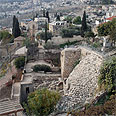

According to the data, Israeli citizens are abandoning the country's large cities. However, they are not immigrating to the periphery but rather to less crowded areas in central Israel.
The figures reveal that central Israel, Haifa and Judea and Samaria are the only districts where the number of arriving residents surpassed the number of citizens who have left.
The central district recorded a positive internal immigration of some 8,000 residents, compared to 9,700 in 2010, and it remains the district with the highest internal immigration rate for the past two decades.
The Judea and Samaria district recorded a slowdown in the population growth rate, with an increase of 3,100 residents in 2011 compared to 3,500 in 2012.
The Haifa district continued the positive change with 900 residents in 2011, after many years of negative internal emigration.
All other districts had a negative emigration balance, especially the Jerusalem district which recorded a negative rate of 5,100 residents, and the Tel Aviv district where the number of departing residents surpassed the number of arriving residents by 4,000.
Moving to Petah Tikva
Out of Israel's six large cities (Jerusalem, Tel Aviv-Jaffa, Haifa, Rishon Lezion, Petah Tikva and Ashdod), Petah Tikva was the only one to present positive immigration figures in 2011 with 1,900 residents.
These numbers continue the trend seen in 2010, which may be the result of the sharp rise in apartment prices in the big cities.
This trend has not skipped smaller cities (100,000-200,000 residents), although it is less significant there. While three cities (Ashkelon, Netanya and Rehovot) recorded positive internal immigration, the others (Bnei Brak, Beersheba, Ramat Gan, Bat Yam and Holon) registered negative internal emigration in 2011.
Jerusalem leads the negative emigration chart both among cities and among district. The city's negative emigration balance stood at 7,300 residents in 2011, compared to 7,100 in 2010.
This does not mean, however, that the city's population is decreasing. The increase in Jerusalem's population in 2011 was 2.1% in the city and 2.5% in the entire district, mostly thanks to natural growth and the arrival of new immigrants to the city.
Other large cities recorded an increase of less than 1% in their population, and Petah Tikva even registered a negative growth of 0.4% - despite the positive immigration into the city.
The growth rate of the Israeli population in 2011 (natural growth and immigration to Israel) stood at 1.8%. The growth rate in rural communities reached 4.7%, while kibbutzim recorded a significantly high growth rate of 5.9%, likely due to the positive immigration of young couples who prefer to start a family in rural areas.
The CBS figures show that in 2011 Israeli citizens were unsatisfied with large cities and favored rural life, especially after starting a family. It is unclear whether the dissatisfaction has to do with the level of services offered by the municipal authorities or the prices of housing in the city.
There is no argument about one thing: When Israelis leave the city – they don't head to the periphery. Forty percent of Israel's population remained in the center of the country in 2011, compared to only 17% in the north and 14% in the south.















